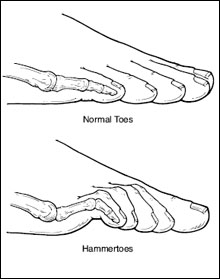
Your NYC podiatrist answers all your burning questions about hammertoes.
Q. What is a hammertoe?
A. A hammertoe is when one or two of the joints in the little toes take on an abnormal bend that appears claw-like in more severe cases. This condition usually develops over time, appearing mild at first and then getting worse.
Q. What causes hammertoe?
A. The most common reason for the development of a hammertoe is a muscle or tendon imbalance in the foot, which can cause the toe to bend. If there are any structural changes that happen in your foot then you may become more prone to developing a hammertoe.
However, a hammertoe can get worse or become exacerbated if you wear shoes that are too tight and don’t fit. Any time your foot has to sit in a cramped or bunched position, the worse it will be for your hammertoe.
Q. What are the symptoms of a hammertoe?
A. Besides the characteristic bending or claw-like appearance of the affected toe, you may also notice pain or discomfort when wearing shoes. A corn or callus may also build up on the toe or between the toes, which are caused by the friction of wearing form-fitted shoes.
You may also experience inflammation, redness or even burning in the hammertoe. For those with more severe cases, you may even notice an open sore.
Q. What are the common hammertoe treatments?
A. The first line of defense against treating hammertoes is also more conservative in nature:
We may recommend wearing corn or callus padding to prevent further irritation and friction.
Your New York City podiatrist will also advise you to change the types of shoes you wear to offer your feet and toes ample room.
Orthotic devices may also benefit you and help take pressure of the affected toe and other parts of your feet when you walk.
If you are experiencing any discomfort or pain, we recommend using over-the-counter anti-inflammatory medications or pain relievers like ibuprofen. This can help reduce any pain or swelling.
Talk to your NYC podiatrist about whether splinting toe may be beneficial and help realign your affected toe.
Will I need surgery for my hammertoe?
There are some patients who don’t respond to non-surgical measure. If the hammertoe becomes painful and severe, then your podiatrist may advise you to get hammertoe surgery in New York City. However, this is usually the last measure taken to treat a hammertoe and is only recommended when absolutely necessary.
If you are dealing with a bent or painful toe then it’s time to find out if you are experiencing the beginning stage of a hammertoe. The sooner we catch this problem the easier it is to treat so it doesn’t get worse. Schedule an appointment today with your NYC podiatrist, Dr. Gary Evans.
- Posted on April 27, 2015
- Tags Hammertoes
- Categories Foot Care